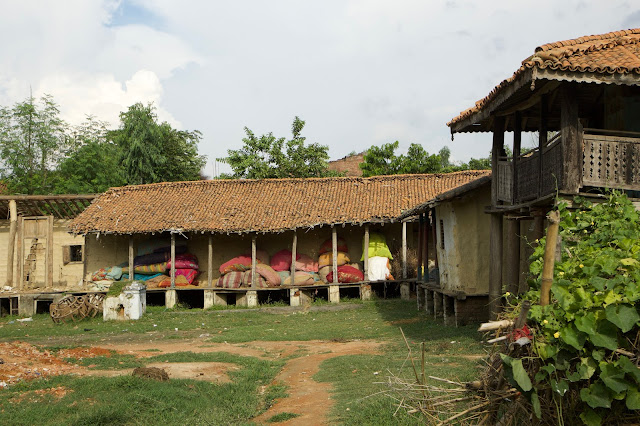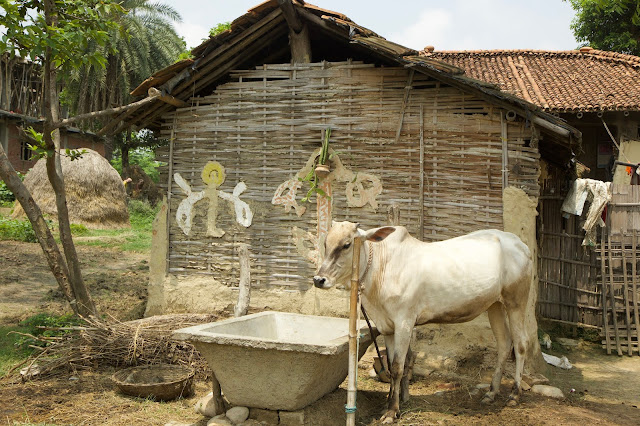Bardibas and Jankapur - the plains of Nepal
Floods are a common mountain hazard.
At the end of July 2017, before the disastrous floods that began on 11th August, I went with a group from ICIMOD to visit their flood early warning systems in Bardibas and Bhittamore outside Janakpur near the India border.During our drive from Kathmandu, the rivers were already running up to the edges of paddy lands with lots of sediments from recent rains.
A suspension bridge connects the opposite side to the main highway. There are no roads on the other side but one is planned. Houses are numerous on both sides of the river.

The hotel in Bardibas was comfortable with a meeting room so that we could talk to the community about the Flood Early Warning System.

The bridge over the Ratu Khola is very busy with lots of traffic - it is a main part of the East-West highway. The west end of the bridge had partially collapsed from sand mining. A new bridge was under construction, but with continued sand mining, the same thing will likely occur.


The river flow in the Terai or the plains was very little at that time - almost nothing to tap for the irrigation channel off to one side. It looks fairly harmless. Just less than 500 meters to the east is a small village where an early warning flood system is installed.

The caretaker of the system proudly shows off the device and describes how he notifies people in his village and downstream of a dangerous rise in the river.
 The marker for the flood water is under the bridge. A new bridge is being constructed next to the old one. As the Ratu River rises it will trigger a sensor that is sent to the caretaker's house.
The marker for the flood water is under the bridge. A new bridge is being constructed next to the old one. As the Ratu River rises it will trigger a sensor that is sent to the caretaker's house. People in the community gather for a meeting to discuss the flood early warning system. They learn how it works and how they will participate. The group visited the site and held a meeting at the hotel.
People in the community gather for a meeting to discuss the flood early warning system. They learn how it works and how they will participate. The group visited the site and held a meeting at the hotel.

 As a side trip, we visited a village outside Bardibas that was made for untouchables or Dalits. It was generously constructed by two film actors under their Dhurmus-Suntali Foundation. About 60 Musahar families were moved into this new housing area from miserable conditions. Now their children can go to school and hopefully, they will have a better future. They have electricity and running water and keep the area clean.
As a side trip, we visited a village outside Bardibas that was made for untouchables or Dalits. It was generously constructed by two film actors under their Dhurmus-Suntali Foundation. About 60 Musahar families were moved into this new housing area from miserable conditions. Now their children can go to school and hopefully, they will have a better future. They have electricity and running water and keep the area clean.These are a few of the many Musahar children who now attend a school just within walking distance.

Nearby paddy fields were being prepared for planting and some were already planted with small seedlings. Everyone was working until late in the evening to get their fields planted. The floods that came two weeks later wiped out their fields and their food supplies for the coming year.

 Then the men entered the room and all the women were in the back.
Then the men entered the room and all the women were in the back.
A few women stood and explained their experiences with the floods. Afterward,d we had a colorful group photo.

One beneficial outcome of the meeting was the inclusion of Indian officials from the downstream community. They attended the meeting with the Nepali officials and the community on the Nepali side. They agreed to exchange phone numbers. Then when the floods came 2 weeks later they were able to give the downstream people several hours warning, helping them to evacuate their families and animals.


This is the device that would signal a flood within two weeks Hard to picture how high and fast the water rises - up to the top of the pole in the photo. When the villagers receive a warning signal they start moving out of their homes and call others.

The levee that people are standing on helps to keep the water from the houses beside the river. The water is so low that a man walks across the river water easily.
 At the flat area in front of the meeting hall, a small bazaar begins.
At the flat area in front of the meeting hall, a small bazaar begins. 

It even includes rides.
 Houses are elevated off the ground and grain is stored as high as possible. They know from experience to keep things off the ground.
Houses are elevated off the ground and grain is stored as high as possible. They know from experience to keep things off the ground.The road back to Janakpur was unbelievably awful. I can't imagine what it is like after the floods.

People are living on the edges of the cities that come for construction work (some are from India) or are Dalit and not allowed to live in the city. These people will not be reached in time to warn them of the floods.
Janakpur is famous for the Janaki Mandir dedicated to the goddess Sita. Sita is believed to have been born in Janakpur and the temple there celebrates her life. She was married to Lord Rama and their marriage occurred in the area.
A group of Bol Bam pilgrims dressed in orange were visiting at the same time.
Religious and cultural tourism are the main attractions of the Janaki Mandir. The colorful architecture is Hindu-Rajput style. At one time there was a train link to India from Janakpur. It is being refurbished and should run again shortly.

Selling religious items is common outside the temple, but everyone seems to be selling the exact same stuff.
 The whole place is colorful and festive. Below is the Global Law Firm in case you get into trouble in Janakpur.
The whole place is colorful and festive. Below is the Global Law Firm in case you get into trouble in Janakpur. There is a big problem of open defecation in Janakpur as one very literal signboard shows and it is meant to disgust people, but it still goes on. In the morning from our hotel room looking at the fields below it was obvious that the practice continued. The floods will "flush the toilet" temporarily. This sign was placed on the fencing of the Ram Mandir so it wasn't hidden away.
There is a big problem of open defecation in Janakpur as one very literal signboard shows and it is meant to disgust people, but it still goes on. In the morning from our hotel room looking at the fields below it was obvious that the practice continued. The floods will "flush the toilet" temporarily. This sign was placed on the fencing of the Ram Mandir so it wasn't hidden away.
Another side trip was to the Mithila Art Center about a 20-minute drive from Janakpur. Driving through the Mithila villages - their artwork decorates their homes.
Nari Bikas Kendra or the Mithila Art Center has a salesroom where paintings, clay figures, plates and bowls, and Mithila art printed clothing can be bought. This is just outside of Janakpur in a village area. It is worth the time to visit.
The handprints are for identification and maybe decoration. Many animals were killed in the floods.
At the end of the floods in Nepal, India, and Bangladesh the human casualty was 1600, animal numbers in the thousands plus many wild animals such as rhinos, tigers, deer, and gaur also perished. It will take years for the area to recover.

















Comments
Post a Comment